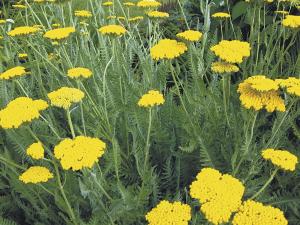Yarrow attracts beneficial insects to garden
Thanksgiving is a time for timeless traditions. One of the oldest traditions in the world predates modern Thanksgiving by thousands of years. The Chinese book of I Ching is used to divine the future. Fifty-eight stalks of yarrow are used to seek answers in the I Ching.
Our gardens now have plants that can be dried for timeless bouquets, and fittingly, one of the easiest and most common plants is yarrow. The warm shades of yellow lend themselves to the autumn table.
Yarrow is a hardy perennial that will survive in USDA zones 2-9. It blooms with bright flower heads made up of many tiny, tightly packed individual flowers. The 3-foot-tall, fern-like leaves have a pleasant scent.
Plant yarrow for carefree borders, in rock gardens, or as part of a natural or wildflower garden. They make long-lasting cut flowers and when dried will be part of winter everlasting bouquets.
Plant yarrow seed directly in the garden in the spring. It will often bloom in under four months from a spring sowing. Choose a spot with good drainage, and avoid damp or wet areas. These heat-loving plants thrive in hot, dry conditions and actually do best in average to poor soil. If planted in rich soil, they may become too overwhelmed and flop over. They do well in soil with a pH between 5.5 and 7.0.
Because they spread, thin yarrow plants to stand about a foot or two feet apart. Many people find Achillea millefolium plants to be invasive, so keep them in bounds by hoeing or removing any new plants.
Yarrow traditionally was used to stop blood loss. Indeed, part of its scientific name, Achillea millefolium, refers to the Greek god Achilles.
While yarrow is tolerant of low moisture, you may want to water the plants in the summer during long dry spells.
Once established, you can divide yarrow plants about every three to five years. Use a garden fork to gently lift the clumps in early spring or fall. Cut out all the dead stems and break the clumps apart. Replant immediately and water well.
If your yarrow plants suffer from aphids, treat them with a good organic pesticide or powder. They can also get powdery mildew and rust, which can be treated with organic garden powders.
Besides the classic yellow, yarrow comes in many pastel shades. The variety Coronation Gold has warm mustard-yellow flowers above silver-gray leaves. For a deep red shade, try The Beacon, while Cerise Queen blooms in a soft pink. The variety Summer Berries will give you salmon, apricot, pink and cream, including many two-tones.
For more blooms, be sure to cut out old flowers as they fade. Yarrow looks great when interplanted with coneflower and celosia. Yarrow attracts beneficial insects to your garden, such as ladybugs.
Many gardeners feel that planting yarrow near aromatic herbs makes the herbs more flavorful, with stronger essential oil production, so try putting yarrow among your basil, chives, rosemary, and oregano.
Harvest yarrow now for fresh bouquets or dried arrangements, or wrap bundles of fifty-eight stalks of yarrow for an I Ching gift that is, shall we say, unpredictable.



















































